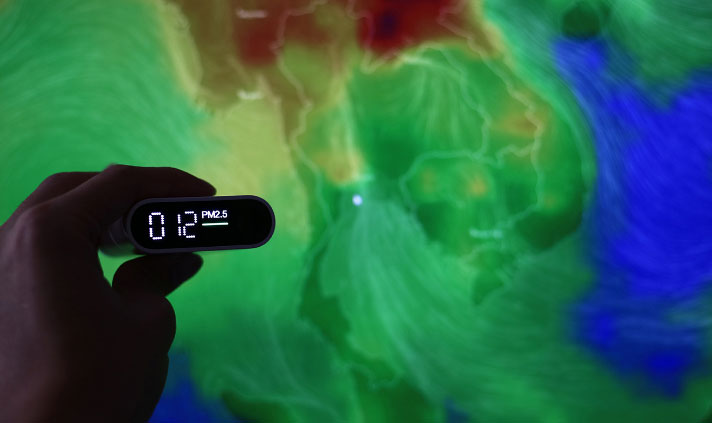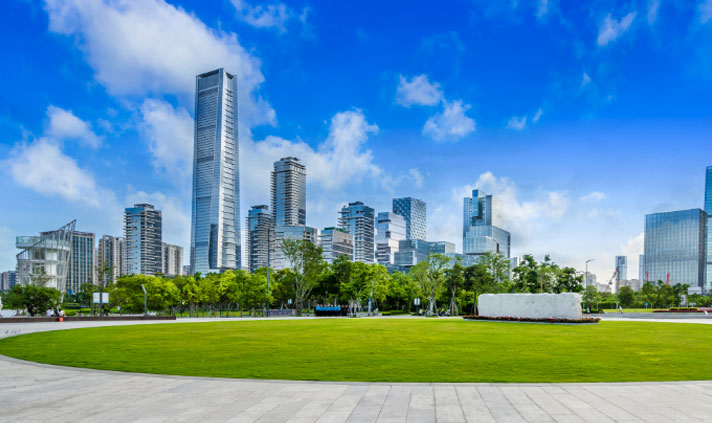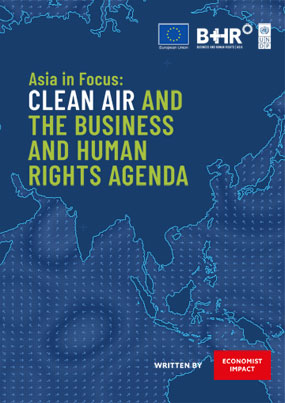Asia in Focus:
Clean Air
and
the business
and human
rights agenda

Asia in Focus:
Clean Air
and
the business
and human
rights agenda

 Conclusion
Conclusion
Air pollution is among the most urgent challenges faced by Asia today. There is mounting evidence of health impacts in the shape of rising incidence of respiratory illnesses and air pollution-related mortality. Urban centres are witnessing a steady increase in the number of residents leaving due to hazardous levels of air pollution. The scale and seriousness of the problem has clearly come to a tipping point.
There is mounting evidence of health impacts in the shape of rising incidence of respiratory illnesses and air pollution-related mortality. Urban centres are witnessing a steady increase in the number of residents leaving due to hazardous levels of air pollution. The scale and seriousness of the problem has clearly come to a tipping point.
The debilitating impact of air pollution has huge economic and social implications. The public health and economic costs from air pollution can cause losses of up to 3.3% of global GDP, accounting for the loss of income, productivity, investment, urban competitiveness and biodiversity in a country.150 Polluted air is a silent killer that is affecting the well-being and quality of life of future generations as well through its impact on maternal and neonatal health. However, the impacts and costs of air pollution are not borne equally. Vulnerable groups such as women, informal economy workers, low-income families and Indigenous Peoples experience much greater harm, especially when they lack the adequate platforms and political representation to voice their concerns or access remedy.
3.3%
The public health and economic costs from air pollution can cause losses of up to 3.3% of global GDP, accounting for the loss of income, productivity, investment, urban competitiveness and biodiversity in a country.
The UN resolution HRC/RES/48/13: 'The human right to a clean, healthy and sustainable environment' is a major step in the recognition of clean air as a basic human right. Despite the legally non-binding status, the resolution is expected to compel States and businesses to take action towards improving air quality. By recognising clean air as a basic human right, the resolution brings the issue of air pollution directly within the remit of the UN Guiding Principles on Business and Human Rights. However, a key challenge remains: industries directly contributing to poor air quality are also some of the largest drivers of economic growth in the region. Getting these industries to take concrete steps towards improving air quality requires dedicated legislative action from governments and a commitment from industry to embrace long-term thinking.
The UN Guiding Principles on Business and Human Rights provide a useful framework for States and businesses to begin taking steps to improve air quality. The three pillars of the framework—the State duty to protect, the corporate responsibility to respect, and the responsibility of both State and business to provide access to remedy—provide practical recommendations for governments and business to play their role in achieving the collective objective of improvement in air quality. To carry out its duty to protect, the State must mandate air quality standards, while monitoring compliance by both private and State enterprises. The State should also ensure policy coherence among ministries, develop and update appropriate legislation and regulations, and leverage its role as a market actor to motivate private sector enterprises. The State must also ensure that affected populations have adequate access to remedy in the form of legal recourse.


Businesses should take measures to mitigate air pollution caused as a direct or indirect result of their operations. Business enterprises should demonstrate commitments toward reducing air pollution through policy statements, implementing due diligence processes, detailed stakeholder consultations and complying with local air quality standards. Businesses should also invest in research and development to identify new technologies and processes that could potentially reduce their direct and indirect contributions to air pollution.
Successes in achieving improved air quality in Asia is evidence that improving air quality is not an unattainable goal. Improving air quality requires dedicated and coordinated action from all stakeholders, including the government and the private sector. With the necessary political will and committed action from all stakeholders, significant improvements in air quality can be achieved.
 Acknowledgements
Acknowledgements
 Asia
in focus: Clean Air and the Business and Human Rights
Agenda is a report written by Economist Impact in
consultation and with support from UNDP. The findings are based on an
extensive literature review, an expert interview programme and data analysis
conducted by Economist Impact between January and
March 2022.
Asia
in focus: Clean Air and the Business and Human Rights
Agenda is a report written by Economist Impact in
consultation and with support from UNDP. The findings are based on an
extensive literature review, an expert interview programme and data analysis
conducted by Economist Impact between January and
March 2022.
The report was written by a team of researchers
including Shreyansh Jain, Divya Sharma Nag and Minakshi Barman. Levi Heo,
Sachin Javale and Cheryl Fuerte were responsible for the report’s design
layout. The report was copyedited by Jan Copeman.
Interviewees
Our thanks are due to the following people for their time and insights:
Ahmad Rafay Alam – Environmental Lawyer and Activist
Grita Anindarini – Deputy Director, Indonesian Centre for Environmental Law
Matthew Baird – Director of Asian Research Institute for Environmental Law and Doctoral Candidate, University of Southern Queensland
Victor Bernard – Programme Officer (Human Rights and the Environment)
Prarthana Borah – Director, CDP India
Dr David Boyd – United Nations Special Rapporteur on Human Rights and the Environment, Associate Professor, Institute for Resources, Environment and Sustainability, School of Public Policy and Global Affairs, University of British Columbia
Paulo Burro – Co-Convenor, Bayanihan sa Daan
Joan Carling – Executive Director, Indigenous Peoples Rights International (IPRI)
Professor Surya Deva, Member – UN Working Group on Business and Human Rights
Dr Michael Greenstone – Milton Friedman Distinguished Service Professor in Economics; Director, Energy Policy Institute at the University of Chicago (EPIC); Director, Becker Friedman Institute, University of Chicago
Roger Joseph (Rocky) Guzman – Deputy Director, Asian Research Institute for Environmental Law
Allan Meso – Environmental Lawyer
Polash Mukerjee – Lead, Air Pollution and Climate Resilience, Natural Resources Defence Council, India
Brynn O' Brien – Executive Director of the Australasian Centre for Corporate Responsibility (ACCR)
Kevin Punzalan – former Senior Policy Officer, Embassy of the Kingdom of the Netherlands in the Philippines. Currently an International Business Developer for VDE Renewables GmbH.
William Schulte – Mekong Region Policy and Legal Advisor, EarthRights International
Romchat Wachirarattanakornkul – National Human Rights Officer on Climate Change and the Environment, Office of the UN High Commissioner for Human Rights (UN OHCHR) Regional Office for South-East Asia.
Christine Wellington-Moore – SDG Integration Advisor, UNDP
Hemantha Withanage – Senior Advisor, Centre for Environmental Justice (Sri Lanka)
Thailand Clean Air Network
We would also like to extend our gratitude to Sean Lees, Anna Keller, Belinda Hlatshwayo, Jiahuan Yuan and other UNDP staff for the technical support provided during the project.
Download the report
Access the footnote sources, appendix information and charts by downloading the full PDF report
UNDP is the leading United Nations organisation fighting to end the injustice of poverty, inequality, and climate change. Working with our broad network of experts and partners in 170 countries, we help nations to build integrated, lasting solutions for people and planet. Learn more at undp.org or follow at @UNDP. For more information on the Business and Human Rights in Asia programme visit the B+HR website here or follow at:
Disclaimer: The designations employed and the presentation of material on maps used do not imply the expression of any opinion whatsoever on the part of the Secretariat of the United Nations or UNDP concerning the legal status of any country, territory, city or area or its authorities, or concerning the delimitation of its frontiers or boundaries.
Hero globe image credits: The globe image at the top of this website page is an open source code by Cameron Beccario https://github.com/cambecc/earth and https://earth.nullschool.net/about.html

References
X1 https://www.ccacoalition.org/en/content/air-pollution-measures-asia-and-pacific
3 For the full list of UNGPs, see > https://www.ohchr.org/sites/default/files/documents/publications/guidingprinciplesbusinesshr_en.pdf
5 Greenpeace Southeast Asia and Centre for Research on Energy and Clean Air
6 https://www.ncbi.nlm.nih.gov/pmc/articles/PMC6923778/#B3
8 https://twitter.com/hp_tourism/status/1246017228274728960
10 https://www.who.int/news/item/04-04-2022-billions-of-people-still-breathe-unhealthy-air-new-who-data
11 https://www.ccacoalition.org/en/content/air-pollution-measures-asia-and-pacific
12 https://timesofindia.indiatimes.com/india/india-third-most-polluted-country-delhi-most-polluted-capital-report/articleshow/81537532
world-air-quality-report-2020-en-pdf
(2020 Report-English -
page 4, section on Executive summary) More recent data is available from the same source but was
released after the report went into production.
13 US AQI >100 https://www.airnow.gov/aqi/aqi-basics/#:~:text=Think%20of%20the%20AQI%20as,300%20represents%20hazardous%20air%20quality
world-air-quality-report-2020-en-pdf
(2020 Report-English -
page 4, section on Executive summary) More recent data is available from the same source but was
released after the report went into production.
14 https://timesofindia.indiatimes.com/india/india-third-most-polluted-country-delhi-most-polluted-capital-report/articleshow/81537532
<
world-air-quality-report-2020-en-pdf
(2020 Report-English
- page 4, section on Executive summary) More recent data is available from the same source but was
released after the report went into production.
15 https://aqli.epic.uchicago.edu/pollution-facts/
16 https://pubmed.ncbi.nlm.nih.gov/33735795/
17 https://www.stateofglobalair.org/
18 https://www.iarc.who.int/wp-content/uploads/2018/07/pr221_E.pdf
22 https://ourworldindata.org/outdoor-air-pollution
25 https://energyandcleanair.org/publications/costs-of-air-pollution-from-fossil-fuels/
26 https://www.ccacoalition.org/en/content/air-pollution-measures-asia-and-pacific
27 https://www.who.int/news-room/fact-sheets/detail/ambient-(outdoor)-air-quality-and-health
28 https://www.who.int/news-room/fact-sheets/detail/ambient-(outdoor)-air-quality-and-health
29 "Air quality guidelines (AQGs) released by the WHO provide recommendations on air quality levels as well as interim targets for six key air pollutants. These are based on the extensive scientific evidence currently available; the guidelines identify the levels of air quality necessary to protect public health worldwide. The AQGs also serve as a reference for assessing if, and by how much, the exposure of a population exceeds levels at which it might cause health concerns. They cover some of the most monitored pollutants critical for health, for which evidence on health effects from exposure has advanced the most in the past 15 years.” https://www.who.int/news-room/questions-and-answers/item/who-global-air-quality-guidelines
30 https://www.iqair.com/blog/air-quality/2021a-WHO-air-quality-guidelines
31 https://www.sciencedirect.com/science/article/pii/S1352231015303320#appsec1
32 https://www.sciencedirect.com/science/article/pii/S0048969720336111
33 https://www.sciencedirect.com/science/article/pii/S0048969720336111
34 https://www.ncbi.nlm.nih.gov/pmc/articles/PMC6923778/
35 https://www.ncbi.nlm.nih.gov/pmc/articles/PMC6923778/#B3
36 https://undocs.org/A/HRC/RES/48/13
37 United Nations, General Assembly, The human right to a clean, healthy and sustainable environment, A/76/L.75 (26 July 2022)
38 https://documents-dds-ny.un.org/doc/UNDOC/GEN/G20/202/42/PDF/G2020242.pdf?OpenElement
39 Interview insight - Dr Surya Deva
40 https://undocs.org/en/A/RES/64/292
41 https://news.un.org/en/story/2021/10/1103082
42 https://www.ohchr.org/en/NewsEvents/Pages/DisplayNews.aspx?NewsID=26116&LangID=E#_ftnref2
44 https://ideas4development.org/en/right-water-fundamental-human-right/
47 https://www.ohchr.org/documents/issues/business/a-hrc-17-31_aev.pdf
48 https://www.ohchr.org/documents/issues/business/a-hrc-17-31_aev.pdf
49 https://www.adb.org/sites/default/files/publication/659631/climate-litigation-asia-pacific.pdf
53 https://discovery.ucl.ac.uk/id/eprint/894/1/Millennium_rvw_final_october.pdf
54 https://tcc-gsr.com/wp-content/uploads/2021/06/1.3-Asia-Regional-Overview.pdf
55 Calculations by Economist Impact, based on data from https://data.adb.org/dataset/asian-transport-outlook-database (See Asia Transport Outlook Database – Excel file name > ‘National air pollution and health’, Sheet name> ‘APH-VAP-031’
56 https://www.channelnewsasia.com/world/explainer-power-impact-climate-change-1339031
58 https://www.stateofglobalair.org/data/#/air/plot
59 https://www.stateofglobalair.org/data/#/air/plot
61 https://blogs.adb.org/blog/crystal-clear-asia-s-cities-are-finding-innovative-ways-clean-their-skies
62 Figures are estimates from modelling exercises. Scientific studies that use computer models do not give results with absolute certainty. Instead a range is provided (known as an 'interval'). The ‘confidence range’ is the range that is most likely to contain the true value. A 95% confidence interval means that with 95% probability, reality is somewhere inside the confidence interval, and a 5% chance it is outside the interval (either higher or lower than the range of numbers in the range). The value with the highest probability to be the true value is called the central estimate. It is somewhere inside the confidence interval. The bounds of the confidence interval are called the low and the high estimate.
64 These figures are central estimates. See footnote 60 for a definition of central estimates.
66 https://www.unescap.org/sites/default/files/The%20Economics%20of%20Climate%20Change%20%20in%20the%20Asia-Pacific%20region.pdf (Section on Highlights, page v)
67 https://mitsloan.mit.edu/ideas-made-to-matter/psychological-economic-and-social-costs-air-pollution
68 https://mitsloan.mit.edu/ideas-made-to-matter/psychological-economic-and-social-costs-air-pollution
70 https://www.unep.org/news-and-stories/story/why-legislation-needed-curb-air-pollution
71 https://www.unep.org/news-and-stories/story/five-reasons-you-should-care-about-air-pollution
72 https://bmcpublichealth.biomedcentral.com/articles/10.1186/s12889-018-6025-1
73 https://www.stateofglobalair.org/health/global#Millions-deaths
74 https://aqli.epic.uchicago.edu/the-index/
75 https://aqli.epic.uchicago.edu/the-index/
79 Ground level ozone is a pollutant formed as a result of chemical reactions between oxides of nitrogen and volatile organic compounds in the presence of sunlight. These chemicals are emitted from industrial plants, electric utilities, vehicle exhaust etc.
81 https://www.sei.org/featured/5-ways-reducing-pollution-can-improve-equality-for-women/
82 https://www.ft.com/content/ee08d61d-4c98-4398-9971-93036d67e91e
83 https://impact.economist.com/perspectives/sites/default/files/resettingtheagenda.pdf
87 https://www.un.org/en/observances/biological-diversity-day
88 http://www.equilibriumconsultants.com/upload/document/airpollutionandbiodi4f9.pdf
89 https://www.ilo.org/asia/media-centre/news/WCMS_627585/lang--en/index.htm
92 https://academic.oup.com/cardiovascres/article/116/14/2247/5940460
93 https://www.sciencedirect.com/science/article/pii/S0160412016305992
94 https://asiapacific.unfpa.org/en/news/rights-indigenous-peoples-must-be-protected-and-respected
95 https://www.worldbank.org/en/topic/indigenouspeoples#1
96 https://www.worldbank.org/en/topic/indigenouspeoples#1
98 https://www.unep.org/news-and-stories/story/five-reasons-you-should-care-about-air-pollution
99 https://ourworldindata.org/grapher/pm25-exposure-gdp
100 Interview insight from Prarthana Borah
102 https://www.ccacoalition.org/en/content/air-pollution-measures-asia-and-pacific
103 https://cil.nus.edu.sg/wp-content/uploads/2020/05/2013-Updated-APMS-1.pdf
104 https://www.eria.org/ERIA-DP-2015-82.pdf
105 https://www.greenpeace.org/southeastasia/press/3239/a-haze-free-asean-by-2020-are-we-there-yet/
106 https://theicct.org/sites/default/files/publications/Indonesia-sootfree-CBA-02182020.pdf
109 https://www.iqair.com/world-most-polluted-cities/world-air-quality-report-2020-en.pdf
110 https://www.unep.org/news-and-stories/story/air-pollution-choking-bangkok-solution-reach
112 https://www.iqair.com/world-most-polluted-cities/world-air-quality-report-2020-en.pdf
113 https://www.mdpi.com/2032-6653/12/1/2/pdf
114 https://www.iqair.com/world-most-polluted-cities/world-air-quality-report-2020-en.pdf
116 https://theicct.org/sites/default/files/publications/India%20BS%20VI%20Policy%20Update%20vF.pdf
117 https://www.pmuy.gov.in/about
119 https://www.sciencedirect.com/science/article/pii/S2590162120300368
120 https://www.iqair.com/world-most-polluted-cities/world-air-quality-report-2020-en.pdf
122 https://www.kasa.gov.my/roadmap/Roadmap_KASA_2020-2030-en.pdf
124 https://www.pna.gov.ph/articles/1159659
125 https://changing-transport.org/modernizing-public-transport-in-the-philippines/
126 https://www.officialgazette.gov.ph/2016/01/28/govt-supports-road-sharing/
128 https://bmcpublichealth.biomedcentral.com/articles/10.1186/1471-2458-10-300
133 https://energyandcleanair.org/china-14th-five-year-plan-carbon-neutrality/
135 http://english.www.gov.cn/news/topnews/202109/09/content_WS6139a111c6d0df57f98dfeec.html
136 https://aqli.epic.uchicago.edu/country-spotlight/china/
140 https://epic.uchicago.in/wp-content/uploads/2019/10/ETS_INDIA_ResearchSummaryFinal-.pdf
142 https://epic.uchicago.in/wp-content/uploads/2019/10/ETS_INDIA_ResearchSummaryFinal-.pdf
144 https://www.tandfonline.com/doi/abs/10.1080/09644016.2017.1338213?journalCode=fenp20
145 https://smartcities.gov.in/climatesmart_cities
146 https://www.niua.org/csc/assets/pdf/key-documents/phase-2/CSCAF-2.0-Brochure_24042020.pdf
147 For the full list of UNGPs, see > https://www.ohchr.org/sites/default/files/documents/publications/guidingprinciplesbusinesshr_en.pdf
150 Garton, Kelly, Thow, Anne Marie & Swinburn, Boyd. (2020). International Trade and Investment Agreements as Barriers to Food Environment Regulation for Public Health Nutrition: A Realist Review. Journal of Health Policy and Management.
151 For the full list of UNGPs, see > https://www.ohchr.org/sites/default/files/documents/publications/guidingprinciplesbusinesshr_en.pdf
152 https://unfccc.int/sites/default/files/resource/Considerations%20regarding%20vulnerable.pdf
153 https://www.sei.org/featured/5-ways-reducing-pollution-can-improve-equality-for-women/
155 Not exhaustive





 @BizHRAsia_UNDP
@BizHRAsia_UNDP /UNDPBHR
/UNDPBHR
